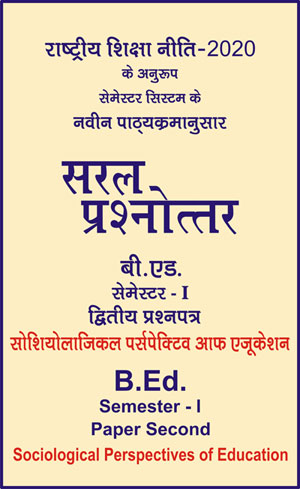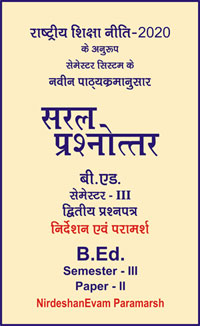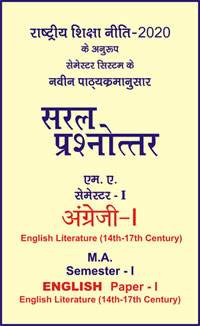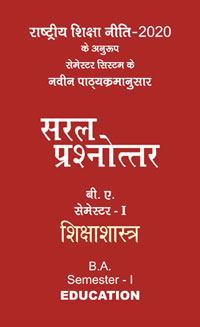|
बी एड - एम एड >> बी.एड. सेमेस्टर-1 प्रश्नपत्र-II - सोशियोलाजिकल पर्सपेक्टिव आफ एजूकेशन बी.एड. सेमेस्टर-1 प्रश्नपत्र-II - सोशियोलाजिकल पर्सपेक्टिव आफ एजूकेशनसरल प्रश्नोत्तर समूह
|
|
|||||||
बी.एड. सेमेस्टर-1 प्रश्नपत्र-II - सोशियोलाजिकल पर्सपेक्टिव आफ एजूकेशन (अंग्रेजी भाषा मे)
OBJECTIVE TYPE QUESTIONS
For each of the following questions, four alternatives are given for the answer. Only one of them is correct. Choose the correct alternative:
-
Which of the following is described as the ‘Soul of the Constitution’?
(a) Fundamental Rights
(b) Fundamental Duties
(c) Directive Principles of State Policy
(d) Preamble -
The Preamble to the Indian Constitution is based on :
(a) Philosophy of India
(b) ‘Objective Resolution’ drafted and moved by Pandit Nehru
(c) Indian Culture
(d) Religious Concept -
The term ‘We’ in Preamble means :
(a) Indian Government
(b) Supreme Courts
(c) Indian Parliament
(d) The People of India -
Indian Constitution ensures ‘Justice’ in which of the following form :
(a) Social
(b) Economic
(c) Political
(d) All of the above -
Preamble has been amended by which Amendment Act?
(a) 27ᵗʰ Constitutional Amendment
(b) 42ⁿᵈ Constitutional Amendment
(c) 44ᵗʰ Constitutional Amendment
(d) 40ᵗʰ Constitutional Amendment -
In which case, the Supreme Court specifically opined that Preamble is ‘not’ a part of the Constitution?
(a) Berubari Union case
(b) Kesavananda Bharati case
(c) Both (a) and (b)
(d) None of the above -
In which case, the Supreme Court rejected the earlier opinion and held that Preamble is an integral part of the Constitution?
(a) Berubari Union case
(b) Kesavananda Bharati case
(c) Both (a) and (b)
(d) None of the above -
The Preamble states that the Constitution derives its authority from :
(a) Indian Culture
(b) Government of India
(c) The People of India
(d) Princely states -
As per Preamble, date of adoption of the Constitution is :
(a) 26ᵗʰ January 1950
(b) 26ᵗʰ November 1949
(c) 11ᵗʰ December 1946
(d) None of the above -
42ⁿᵈ Constitutional Amendment (1976) added which of the terms to the Preamble
(a) Socialist
(b) Secular
(c) Sovereign
(d) Both (a) and (b) -
Which part of the Indian Constitution expressly declares that India is a Sovereign Socialist Secular Democratic Republic?
(a) Fundamental Rights
(b) Directive Principles of State Policy
(c) Preamble
(d) Fundamental Duties -
‘Economic Justice’ as one of the objectives of the Indian Constitution has been provided in :
(a) the preamble and the Fundamental Rights
(b) the Preamble and the Directive Principles of State Policy
(c) the Fundamental Rights and the Directive Principles of State Policy
(d) None of the above -
The correct sequence of the following words in the Preamble is :
(a) Sovereign, Democratic, Socialist, Secular, Republic
(b) Sovereign, Socialist, Secular, Democratic Republic
(c) Sovereign, Socialist, Democratic, Secular, Republic
(d) None of these -
The Constitution of which country was the first to begin with a Preamble?
(a) USA
(b) India
(c) Britain
(d) Canada -
The ideal of Justice (Social, Economic and Political) in the Preamble draws its inspiration from :
(a) Russian Revolution
(b) American Civil War
(c) French Revolution
(d) Japanese Constitution -
The ideals of liberty, equality and fraternity in the Preamble have been taken from :
(a) French Revolution
(b) Russian Revolution
(c) American Civil War
(d) None of the above -
Which of the following is true about Preamble?
(a) It is a source of power to legislature and a source of prohibition upon the powers of legislature.
(b) It is justiciable.
(c) Its provisions are enforceable in courts of law.
(d) None of the above. -
What does the term ‘Secular’ mean in the Indian context?
(a) All religions are equal in the eyes of the government and the State does not uphold any particular religion as its official religion.
(b) Special importance to a religion related to minorities.
(c) One religion is promoted by the government.
(d) None of the following. -
The 42ⁿᵈ Constitutional Amendment added which of the following 4 words in the Preamble?
(a) Socialist
(b) Secular
(c) Integrity
(d) All of the above -
Which of the following words is not mentioned in the Preamble to the Indian Constitution?
(a) Sovereign
(b) Socialist
(c) Democratic
(d) Indians -
The word ‘Sovereign’ mentioned in the Preamble implies .........
(a) India in an Independent State.
(b) India is neither a dependency nor a dominion of any other nation.
(c) India is free to conduct its own affairs (both internal and external).
(d) All of the above -
Which of the following statements is/are true?
(a) India’s membership of the Commonwealth of Nations does not affect India’s Sovereignty in any manner.
(b) India’s membership of United Nations Organization (UNO) does not limit India’s Sovereignty.
(c) India can either acquire a foreign territory or cede a part of its territory in favor of a foreign state.
(d) All of the above. -
Till now, the Preamble to the Constitution of India has been amended for how many times?
(a) Once
(b) Twice
(c) Thrice
(d) Never -
In which of the following, are the basic aims and objectives of the Indian Constitution discussed?
(a) Part-I
(b) Preamble
(c) Part-II
(d) Schedule -
Which among the following statements is incorrect?
(a) The objectives resolution passed by Pt. Nehru was what became the Preamble to the Constitution of India.
(b) Preamble is enforceable in the court of law.
(c) Preamble has been amended only once in 1976.
(d) Preambles proves that the sovereignty lies ultimately with the Indian People. -
42ⁿᵈ Constitutional Amendment was done in which year?
(a) 1976
(b) 1966
(c) 1986
(d) 1972 -
Which among the following was the outcome of Kesavananda Bharati vs/ State of Kerala case, 1973?
(a) Preamble is a part of the Indian Constitution and subject to amending power of the Parliament.
(b) Preamble is not a part of the Indian Constitution and no subject to amending power of the Parliament.
(c) Preamble is a part of the Constitution but not subject to amending power of the parliament.
(d) Preamble is not a part of the Constitution but is subject to the amending power of the Parliament. -
The Preamble to the Indian Constitution aims at securing
(a) Dignity of Individual and Unity and Integrity of the nation.
(b) Fundamental Rights to all individuals.
(c) Fundamental Rights to the citizens of India.
(d) Security of tenure to all government servants. -
What is the meaning of ‘equality’ in the Indian Constitution?
(a) Lack of opportunities
(b) Lack of equality
(c) Absence of special privileges to any section of the society, and provision of adequate opportunities for all individuals without any discrimination.
(d) None of the above -
Which of the following terms was not included in a “union of trinity” by Dr. B.R. Ambedkar in his concluding speech in the Constituent Assembly?
(a) Liberty
(b) Flexibility
(c) Equality
(d) Fraternity -
The philosophy underlying the Indian constitution was embodied quite early in the Objective Resolution, which was moved in the first session of the Constituent Assembly (on 13 December 1946) by :
(a) Pandit Jawaharlal Nehru
(b) Sardar Vallabhbhai Patel
(c) Chakravarti Rajagopalachari
(d) Dr. Bhimrao Ramji Ambedkar -
How many Fundamental Duties are in the Indian Constitution?
(a) 9
(b) 11
(c) 12
(d) 20 -
The concept of ‘Welfare State’ in included in which part of the Indian Constitution?
(a) The Fundamental Duties
(b) The Directive principles of State Policy
(c) The Fundamental Rights
(d) Preamble of the Constitution -
The purpose of the inclusion of Directive Principle of State policy in the Indian constitution is to establish :
(a) Social and economic democracy
(b) Gandhian democracy
(c) Political democracy
(d) Social democracy -
‘Equal pay for equal work’ has been ensured in the Indian Constitution as one of the :
(a) Fundamental Rights
(b) Directive Principle of State Policy
(c) Economic Rights
(d) Fundamental Duties -
Right to education Act (2002) was introduced to help which of the following group of society?
(a) All adults who could not get formal education
(b) Those who are interested in technical education
(c) College going teenagers
(d) Children of age of 6 to 14 years -
Fundamental Duties do not enjoy any :
(a) Political sanction
(b) Legal sanction
(c) Social sanction
(d) Moral sanction -
By which Amendment Act the Fundamental Duties of Citizen are included in Indian Constitution?
(a) 42ⁿᵈ Amendment Act
(b) 44ᵗʰ Amendment Act
(c) 56ᵗʰ Amendment Act
(d) 73ʳᵈ Amendment Act -
Under the Constitution of India which one of the following is not a Fundamental Duty?
(a) To vote in public elections
(b) To develop the scientific temper
(c) To safeguard public property
(d) To abide by the Constitution and respect its ideals -
Who is known as the first Law Officer of India?
(a) Chief Justice of India
(b) Attorney General of India
(c) Solicitor General of India
(d) Law Minister of India -
Which Directive Principles bears the direct impact of Gandhi’s moral philosophy?
(a) Protection of the moments of historical importance
(b) Prohibition of the slaughter of cows
(c) Provision of free legal aid and advice
(d) Equal pay for equal work -
The Fundamental Duties were included in the Constitution of India by which of the following Amendment Act?
(a) 40ᵗʰ Amendment Act
(b) 44ᵗʰ Amendment Act
(c) 43ʳᵈ Amendment Act
(d) 42ⁿᵈ Amendment Act -
The Fundamental Duties are mentioned in :
(a) Part-IV A
(b) Part-IV
(c) Part-III
(d) In schedule IV-A -
Which of the following Article of the Indian Constitution contains Fundamental Duties?
(a) 45 A
(b) 51 A
(c) 42
(d) 30B -
Which of the following are Fundamental Duties?
(a) Safeguarding public property
(b) Protecting the sovereignty, integrity and unity of India
(c) Developing scientific temper and humanism
(d) All of the above -
Which of the following committee suggested incorporating Fundamental Duties in the Indian Constitution?
(a) Malhotra Committee
(b) Raghavan Committee
(c) Swaran Singh Committee
(d) Narasimhan Committee -
Which of the following Articles of the Indian Constitution contain the Right to Religious Freedom?
(a) Articles 25-28
(b) Articles 29-30
(c) Articles 32-35
(d) Articles 23-24 -
Which of the following Articles of the Indian Constitution guarantees “Equality Before the Law and Equal Protection of Law within the Territory of India”?
(a) 15
(b) 14
(c) 17
(d) 18 -
Which Article of the Indian Constitution abolishes Untouchability?
(a) Article 18
(b) Article 15
(c) Article 14
(d) Article 17 -
Which of the following is correct with respect to “Right Against Exploitation”?
(a) Prohibition of traffic in human beings and forced labour
(b) Freedom as to payment of taxes for the promotion of any particular religion
(c) Protection of interests of minorities
(d) Equality before the law -
In which part of the Indian Constitution, the Fundamental Rights are provided?
(a) Part II
(b) Part III
(c) Part V
(d) Part IV -
Which of the following are Gandhian Directive Principles?
(1) To organize village panchayats
(2) To secure opportunities for healthy development of children
(3) To promote cottage industries
(a) (2), (3)
(b) (1), (2)
(c) (1), (3)
(d) All of the above -
Which of the following Directive Principles :
(1) Promote the educational and economic interests of SCs, STs, etc.
(2) Minimize inequalities in income.
(3) Secure the participation of workers in the management.
(a) (2), (3)
(b) (1), (2)
(c) (1), (3)
(d) All the above -
Which of the following is/are true regarding Directive Principles of State Policy?
(1) DPSPs are not automatically enforced.
(2) Court can uphold the validity of a law on the ground that it was enacted to give effect t a DPSP.
(a) Only (1)
(b) Only (2)
(c) Both (1) and (2)
(d) All of the above -
Which of the following are criticisms of Directive Principles of State Policy (DPSPs)?
(1) Does not speak of welfare state (2) Illogically Arranged
(3) Conservative (4) Need more principles
(a) (1), (2), (3)
(b) (1), (4)
(c) (2), (3)
(d) All of the above -
Which of the following examples of implementation of Directive Principles?
(1) Planning Commission (2) Wildlife (Protection) Act, 1972
(3) 73rd Amendment Act of 1992 (4) Minimum Wages Act
(a) (1), (2), (4)
(b) (1), (3)
(c) (2), (3), (4)
(d) All of the above -
The purpose of Directive Principles of State Policy is to?
(a) lay down positive instructions which would guide State policy at all levels.
(b) implement Gandhi ji’s idea for a decentralized state.
(c) check the use of arbitrary powers by the government.
(d) promote welfare of the backward section of the society. -
Which part of the Indian Constitution deals with the Directive Principles of State Policy?
(a) Part III
(b) Part IV
(c) Part V
(d) Part VI -
The enforcement of Directive Principles depends most on?
(a) the President
(b) the Court
(c) resources available to the government
(d) Chief Justice of India -
One of the objectives of Directive Principle of State Policy is?
(a) total prohibition
(b) prevention of gambling and lotteries.
(c) making effective provisions for securing the right to work, education and public assistance in case of unemployment, old age, sickness and disablement.
(d) all of these -
What should be done so that the school is to be the guardian of democracy?
(a) Eminent leaders should be invited to school to talk about democracy to teachers and the students.
(b) Democracy should, actually, be lived in the school.
(c) Lessons on the importance of democracy should be included in the text-books.
(d) The teachers should have faith in democracy. -
As one of the Indian constitutional values, secularism means :
(a) No respect for any religion.
(b) Equal respect for all religions and no discrimination in any matter on the ground of religion.
(c) Control of religious activities by the government.
(d) Abolition of all personal religious laws. -
For strengthening democracy as a constitutional value through education, it is necessary to ensure that :
(a) All people have the freedom to live the life they think is the best for them.
(b) People are competitive for progress.
(c) People learn large-hearted tolerance, mutual give and take and appreciation of ways in which people differ from one another.
(d) People are religious and God-fearing. -
“Child is more important than all kinds of books”. This viewpoint of Tagore represents his faith in the following aims of education :
(a) Individual aims
(b) Social aims
(c) A synthesis of individual and social aims
(d) Cultural aims -
Which among the following is the best approach for imparting citizenship training?
(a) Perceptual approach
(b) Exemplary approach
(c) Participatory or experience-based approach
(d) Formal training approach -
The idea of the community school shows that :
(a) The community should essentially participate in the management of the school.
(b) The community should be consulted on construction of curricular programmes of the school.
(c) The community should donate funds for the school liberally.
(d) There must be vital connection between the life of the pupils in the school and the life of the community. -
In Russia the individual is trained to be a communist, Germany a nationalist-socialist in Italy a fascist and in India a secularist. What can be generalized from these facts about the factors influencing the aim of education?
(a) The aim of education is influenced by economic factors.
(b) The aim of education is influenced by social factors.
(c) The aim of education is influenced by political factors.
(d) The aim of education is influenced by religious factors. -
The most important function of education is :
(a) Economic development
(b) Human resource development
(c) Industrial development
(d) Political development -
Which of the following is not characteristic of the “School as the community centre”?
(a) A school is established by some community.
(b) The school helps to improve the quality of living in the community.
(c) A school serves the total population of the community.
(d) A school seeks to evolve its purpose out of the interests and needs of the people in the community. -
Which of the following is not an important consideration in the planning of the development of education in India?
(a) Equity
(b) Quality
(c) Relevance
(d) Religion -
At present social change in India is most influenced by :
(a) Occupational groups
(b) Religious groups
(c) Caste groups
(d) Commercial groups -
Family, school, club, gymnasium, sports and games etc., constitute social groups known as :
(a) Temporary groups
(b) Permanent groups
(c) State groups
(d) Dynamic groups -
Which is not the aim of education for citizenship?
(a) To understand one’s rights and responsibilities
(b) To be a religious person
(c) To earn one’s livelihood in an honest way
(d) To act upon principles bodily -
Which among the following is the most powerful constraint upon universalization of primary education in India?
(a) Regional politics
(b) Shortage of teachers
(c) Cost of universalization
(d) Politics in general -
Caste is a closed group of the society because it :
(a) Protects its members in all emergencies.
(b) Provides many facilities to its members.
(c) Does not permit transfer of its members to another caste.
(d) Brings power to its members. -
The concept of ‘life-long learning’ is an outcome of :
(a) People’s desire to learn more.
(b) Shortage of schools in the country.
(c) The dynamics of the expansion of knowledge.
(d) Country’s need for a large number of educated people. -
Which of the following factors has contributed most to the falling standards of Indian education?
(a) Less competent teachers.
(b) Too much political interference in education.
(c) Government’s apathy.
(d) Non-availability of sufficient funds. -
In a democratic country like India, the relation of society and education is :
(a) It is education that influences the society.
(b) It is society that influences education.
(c) Education and society both influence each other.
(d) Neither education influences society, nor society influences education. -
“Social nature” of the man emphasizes that he :
(a) Must respect all other individual in the society.
(b) Is an essential unit of the society.
(c) Seeks by nature, social contacts and cannot live happily without the society.
(d) Must make as many friends in the society as possible. -
Which of the following statement is not correct about the relation of society and individual?
(a) Living in the society is unavoidable for the individual as he is born in it and his development is not possible without the society.
(b) The individual has many needs for the satisfaction of which he is to depend on the society.
(c) The society imposes of him many kinds of restrictions; and that prevents him from being spoiled.
(d) The society provides the individual with schooling, recreational facilities, job-opportunities etc., which make him live on a higher plane. -
Which of the following factors has most affected the curriculum construction in Indian education?
(a) Child’s nature
(b) Constitutional provisions and democratic ideas
(c) The family
(d) The teacher -
Beginning with ‘family’, the lowest unit, which of the following constitutes correctly sequenced hierarchy of social groups :
(a) Nation-race-clan-tribe-family
(b) Family-clan-tribe-race-nation
(c) Family-tribe-race-clan-nation
(d) Family-trace-clan-tribe-nation -
The ultimate good of every individuals lies in his :
(a) Building up a good society.
(b) Building up a strong society.
(c) Building up an intellectual society.
(d) Building up a highly industrialized society. -
Which of the following is most realistic about the interrelation of society and individual?
(a) As the individual themselves make the society; they are more important than the society.
(b) As the society as a social institution ensures the conditions of individuals development and happiness; the society is above individuals and supreme.
(c) The society is as important for the individuals as the individuals for the society.
(d) As the society is much more complex than the individuals; it is more important. -
Which is not the subject of study in Educational Sociology?
(a) Influence of social order on education.
(b) Influence of education on social order.
(c) Interaction between education and culture.
(d) Children’s aptitude as a factor of academic achievement. -
Education is an instrument of peaceful social change because through it is possible to :
(a) Minimize the chasm of economic disabilities.
(b) Remove regional socio-cultural imbalances.
(c) Check social injustice from being widening.
(d) Achieve all of these. -
Under which article of the Constitution, the Indian states are given right to promote the educational interests of the scheduled castes and scheduled tribes and other backward classes of India :
(a) Article 46
(b) Article 17
(c) Article 14
(d) Article 16 -
The concept of equality of educational opportunity does not mean :
(a) Providing opportunity for education to only those who can afford it.
(b) The right of each child to receive an education suited to his/her character and abilities.
(c) Equal opportunity for all children to reveal differences.
(d) All children must have an equal chance of showing that they can equally profit by education irrespective of advantages or disadvantages of birth. -
Education is a sub-system of the society because :
(a) Its quality and characteristics are influenced by the quality and characteristics of other sub-systems of the society.
(b) It influences the quality and characteristics of other sub-systems of the society.
(c) It brings about changes in the society and changes in the society influence the content and methodology of education.
(d) All of these are possible. -
Which is not an obstacle to equality of educational opportunity in India?
(a) Economic inequality already existing among social classes.
(b) Social experiences of children and their adaptability to education.
(c) Lack of government’s will power.
(d) Inability of the families of low social origin to perceive utility of education. -
Education as a sub-system of the democratic society, must respond to the imperatives flowing from the :
(a) Nature and direction of national development.
(b) Talented members of the society who can contribute to its progress.
(c) Need to strengthen its army to protect its freedom.
(d) Need to maintain peace and order in the society. -
Educational change in India has brought the greatest pressure for social change on :
(a) Industrial workers of the country
(b) The elites of the city
(c) The emerging rich of the villages
(d) The scheduled castes and scheduled tribes -
Education is considered a sub-system of the society because :
(a) It has its own complex structure.
(b) It has its well-defined objectives and functions.
(c) Achievement of society’s goals depends on effective functioning of education and effective functioning of education is dependent on society’s health.
(d) It is an essential service that society has to provide to the people. -
By making elementary education free and compulsory in India indicates :
(a) A unique investment in the present and the future.
(b) An important function to be performed by the government.
(c) An irresistible demand of the people.
(d) A welfare activity which every country is required to engage in. -
The way the emerging economic development in India has brought about a change in the educational system is shown by :
(a) Vocationalization of education at higher secondary level.
(b) Opening of a large number of polytechnics, I.I.Ts., and agricultural universities.
(c) Establishment of a system of industrial schools.
(d) Implementation of adult education programmes in a big way. -
What should be done to make education a powerful instrument of social change?
(a) Curriculum should be changed
(b) Teaching methods should be changed
(c) Examination system should be changed
(d) School education should be strengthened -
The immediate goal of equalization of educational opportunities should be to :
(a) Provide opportunities to all children for the fullest development to their potentialities.
(b) Establish good schools in large numbers.
(c) Abolish public schools.
(d) Establish schools in the villages. -
The study of sociological foundations of education is important because :
(a) Education of the people is important from the point of view of social welfare.
(b) Knowledge of various social forces influencing the educational system is essential for improving the process of education.
(c) Schools are required to follow the sociological principles in organizing their educational programmes.
(d) Sociological foundations of education emphasize practice of democracy in the schools. -
Education in India should be organized in the country so that it helps :
(a) In making the people politically conscious.
(b) In eradicating the unemployment of the educated.
(c) In raising the level of morality of the people.
(d) In checking the crime rate in the country. -
Aims of education get constantly revised and redefined. Who plays the most important role?
(a) Political change has no role to play.
(b) People have no important role to play.
(c) Changes taking place in the larger society play extremely important role.
(d) Religion is also a contributory force. -
The role of education in India seems to be much more important to bring about :
(a) Social and national integration.
(b) A change in the religious beliefs of the people.
(c) A change in the life-style of the people.
(d) A change in the attitudes of the people towards education. -
The need for a national system of education in India is emphasized because :
(a) India is one nation and one people.
(b) India is a developing country.
(c) Local, regional, linguistic and state loyalties tend to make the people forget India.
(d) India has a strong central government.
|
|||||

 i
i 










